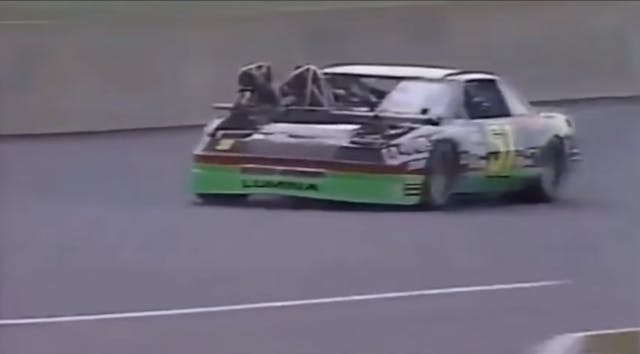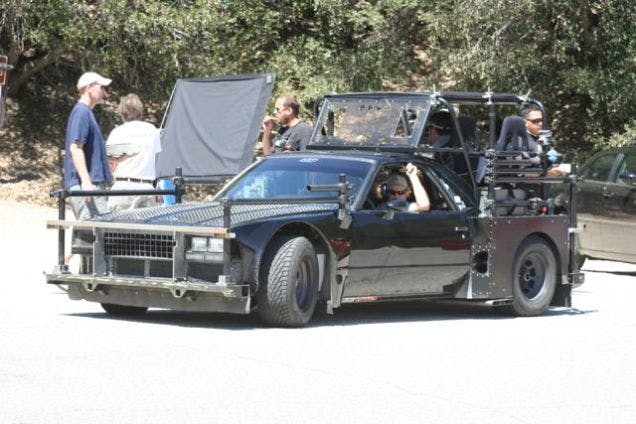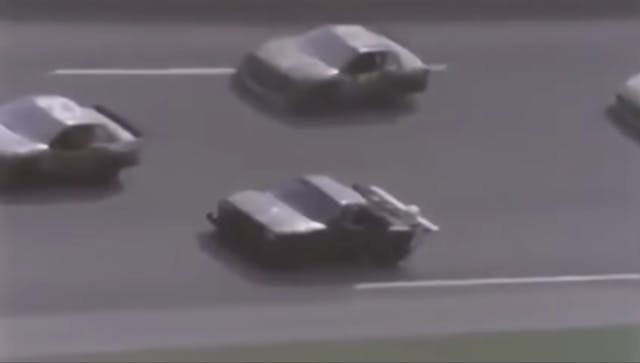There will never be another film like Days of Thunder
1990 Daytona 500 and live-filming
Today, we have enough computer processing power to render anything we could dream of, and that capability has brought substantial cost and time savings to large-scale productions. Thirty years ago, though, there were few ways to fake the funk, especially when under the scrutiny of fans whose entire cultural identity can be summed up by racing number they idolized.
With director Tony Scott and producer Jerry Bruckheimer at the helm, authenticity was the only way to bring this film to life. Filmmakers greenlit builds for custom stunt cars based on actual Cup Cars to enter live NASCAR events. They hired veterans of the banked ovals to load into their live-action stunt cars, like Bobby Hamilton, Tommy Ellis, Hut Stricklin, and Greg Sacks before building a small fleet of Grand National-spec cars with various camera mounts, which still had to pass NASCAR’s tech and qualifying requirements (Hamilton managed to unofficially post a top-10 qualifying time) in order to ensure that the image of speed in theaters didn’t interfere with its reality. The first event they filmed at was the 1989 Checker Autoworks 500 at Phoenix, but the big show came during the 1990 Daytona 500, though not without controversy.

Today it would be unthinkable to have Hollywood going door to door with a team who is actually on that track to make their living that weekend, especially on what is the most prestigious race of their season. Bruckheimer’s production studio paid their toll with the racer’s pot, adding $2000 to everyone’s paycheck that weekend in exchange for 100 miles of their time. Still, CBS’ Ken Squier summed it up best: “Most drivers like the idea of the Top Gun image, but there are those who hold that movie making should not be on their biggest day of thunder.”
NASACARmino filming rig

Because the filmmakers knew that the audiences would scoff at cheap tricks, like speeding the film up to create a sense of speed, unique camera vehicles had to be made in order to film at speeds of more than 150 mph. NASCAR cup cars behave much differently at 50 mph than they do at 150 mph; the vehicle heaves around over bumps and the suspension compression that comes with the high-g loads of the banked corners. Trucks were often the platform for these massive rolling camera rigs, and a unique one from a cut-down van can be seen too, but the tube-chassis El Camino with Mad Max vibes is one of the most dedicated vehicle rigs I’ve ever seen. The El Camino’s body was dropped over a Grand National chassis, which in itself was based on the El Camino’s G-body platform (this was when stock car racing was still based on a stock chassis, although the bodies by 1990 were often reflecting front-drive cars), with a remote-controlled camera rig hanging off the back.

The question of whether it’s a camera truck or camera car is up for debate, but the result was a camera rig that could maintain the speeds necessary to give viewers a real sense of NASCAR racing, producing some of those juicy shots that stop just short of scraping the lens along the pavement in Days of Thunder. The El Camino was never campaigned in NASCAR, but its Chevrolet, Pontiac, Buick, and Oldsmobile brethren did in two-door coupe formats, creating this alternative universe where GM’s iconic ute fought it out on the banks. It’s very reminiscent of the C8 Corvette’s Holden Ute-disguised test mule, dubbed Blackjack.
I want one.
The cost of authenticity

Outside of racing at the two live events, the filmmakers also rented Daytona and restaged the event to shoot more specific, scripted scenes and stunts. This meant they had to buy a fleet of vehicles, all the radio equipment to choreograph the team of drivers and the safety gear for crashes both planned and unplanned, while also building up a list of props and details specific to the few dozen teams they looked to represent in the shots.
Cole didn’t hit the an “Eggson Oil” Chevrolet to avoid licensing fees, exactly, but the team did work to build an authentic “Exxon” replica for our hero to T-bone. Jimmy Johnson lists just a slice of what it took to recreate a day at Daytona, mentioning in a 1991 interview that they bought 33 cup cars (balling up 11 of them into “unrecognizable” shape), $390,000 worth of crew uniforms and racing suits, 75 helmets for their stunt drivers and film crew, 51 radios for commanding the fleet on track through mics and speakers already mounted to the helmets, and somewhere around 100 quick-fill fuel cans and nearly as many fire extinguishers. The cost of racing fuel was, of course immense.
All told, Days of Thunder cost $60 million to produce, a stark increase compared to director Tony Scott’s prior effort, a little $15 million flick known as Top Gun. Thankfully, Days of Thunder more than doubled its money, pulling in $158 million at the box office. Go watch it—the movie holds up, and the action feels real because it almost entirely is.

